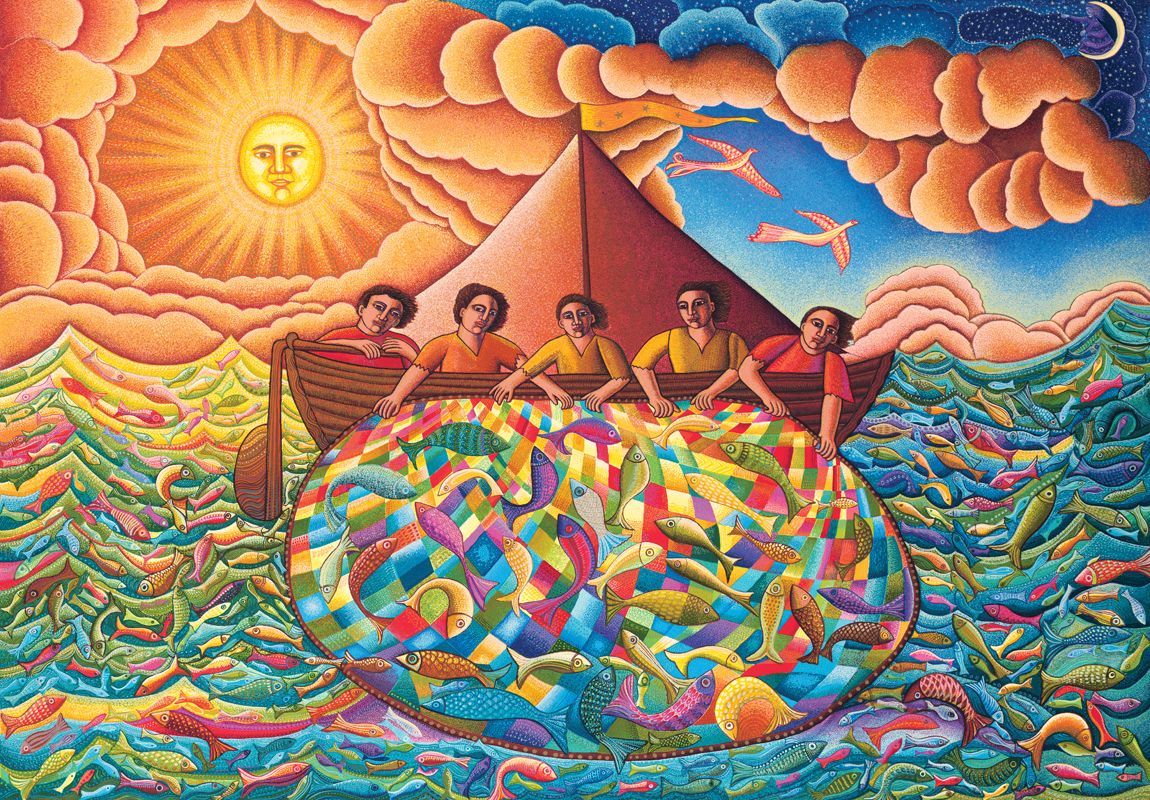I wonder if we have missed the boat about the deeper meaning of Resurrection. Eastertide lasts 40 days before Pentecost, the same length as Lent, but we have no seasonal spiritual practices to shape our vision toward Resurrection. Lent is full of spiritual practices, like giving up something we value to remind us of our need for God. We have daily devotionals and time for self-examination. Holy week includes Palm Sunday, Maundy Thursday, and Good Friday to prepare our hearts. Then we have the big blowout on Easter Sunday. We bring our "A-game" for music and preaching, and fill the chancel with Spring flowers. But then we are done with Easter. I was packed and left for vacation right after church.
The unconscious message of overweighting Lent is that Easter is the happy ending to the sad and dark story of crucifixion rather than the new beginning of the light and life of the Christian story. While Easter is one of the two big Christian holidays to celebrate, Resurrection becomes another event on the calendar. If Easter is only an annual celebration of something which happened centuries ago, then we either believe or disbelieve it. Just because you believe something happened doesn't mean it impacts your life. You can believe Christ was raised from the dead and still be miserable and hate your neighbor. Some people think the Easter story is an interesting myth that never happened, yet they manage to be decent people. So, what is the point of believing the Resurrection is historical if it doesn’t change your life?
I believe in many things about the universe, but it doesn't change my life. The earth rotates on its axis every 24 hours, revolves around the sun every 365 days, and gravity keeps my feet on the ground, and causes objects to fall at the rate of 9.8 m/s2. I haven't done the math myself, but I don't disbelieve these things. But it doesn't change my outlook to believe in the rotation of the earth, the stars, or gravity. The facts don't transform me.
However, if I delve more deeply into the nature of the universe with curiosity, something shifts in me. Standing outside on a starry night, I see a shooting star. I can't comprehend how earth hurtle through space at 67,000 miles per hour, yet I'm standing still. Light from the stars moves faster than I can think this thought. In a moment of awe, I realize the universe is wondrous. Like the writer of Psalm 8, I might think,
When I look at your heavens, the work of your fingers,
the moon and the stars that you have established;
what are humans that you are mindful of them,
mortals[a] that you care for them?
I have moved from knowing facts about the universe to experiencing myself alive in it and sensing a transcendence that grounds me in wonder.
Similarly, how do we move beyond either believing or disbelieving in the Resurrection of Jesus, as an historical event, towards a moment of awe which grounds us? I don't want to convince you the Resurrection is an actual event that happened long ago. I hope to invite you to be curious and open to recognizing the Risen Christ in daily life. The possibility of this encounter is what I want you to believe in. This belief requires more than our logic or agreement. It will take us on a pilgrimage, a spiritual adventure, which will change us to our core.
John’s Gospel invites us to encounter this living presence of the Risen Christ. It calls us to a place beyond belief. Before Jesus raises Lazarus from the dead, Jesus tells Martha, "I am the Resurrection and the life; do you believe this?" She responds with the proper theology, "You are the Christ, the Son of the living God." She believes, but she doesn't yet know what it means. She doesn't expect Lazarus to come out of the tomb, nor does Mary Magdalene expect life when she visits the grave on Easter morning. They must go through the journey beyond belief to a living encounter.
Our story in John this morning moves in a similar direction. Peter and the disciples have gone back to Galilee, and I wonder why since they have seen the Risen Christ twice already. Peter, showing bold leadership, says, "I'm going fishing." Are they really going back to fishing after everything they have seen? Maybe they needed a vacation like I did after a long Holy Week. Or perhaps they just didn't know what to do next. What are you supposed to do with the knowledge of someone you know rose from the dead?
After fishing all night, and a man calls to them, "Did you catch any fish?" "No," they answer. (The narrator tells us this is Jesus, but they are still in the dark.). Once again, we have a story where the main characters do not recognize Christ when they first see him. Mary Magdalene thought Jesus was the gardener. On the road to Emmaus, Cleopas thought Christ was a random traveler. Now Christ is hidden as a guy giving fishing tips.
"Caste the net on the right side of the boat, and then you will find some fish." What do you have to lose with one more try? Now they catch so many fish they can't get their nets hauled in. Then a disciple says, "It is the Lord." Notice the awareness isn't from hearing Jesus' voice calling to them. Recognition comes from experiencing the abundance of fish when they did not expect it. They experience this catch as a Christ-filled-moment. If you are a fisherman (or here in Maine, a lobsterman!), there is nothing better than a good catch. The disciples were fishermen, and when they got the best catch ever, their minds went straight to "Christ is Risen." Peter is so thrilled he abandons the catch to go see Jesus. (He was fishing naked, so he puts his clothes on, then dives in the water. Peter always makes life interesting!)
The story invites us to experience the reality of the Risen Christ whenever we receive abundance and grace in the world. In practical terms, all the sunrise and sunset pictures you post on Facebook, the taste of the first fruit of your garden, the smell of lavender finally blossoming are signs of God's grace and goodness. Theologians have a word for these experiences. General revelation is knowledge about God received through nature, history, and our perception. The creator leaves a trace for us to notice. In the creation story of Genesis, after each day of creation, God looks at the world and says, "It is good." God's goodness is sprinkled all over the Boothbay peninsula. Taking the time to notice and receive the gifts of beauty and awe is a spiritual practice. The Divine meets us in the ordinary things of life and shows us the extraordinary nature of a life filled with the glory of God.
I propose a rhythm of spiritual practice that gives us continuity from Lent through Easter. In Lent, we work at letting go and giving up things that hinder us. We challenge the Lordship of ego and honestly face our shortcomings. Lent calls us to make space for God and face suffering as Jesus confronts the cross. Easter practices should follow through on this process. We shift toward receiving the wonder and generosity of God's goodness. We have done our soul-searching and moved our ego out of the way so we might notice God's presence. Early Christians tied Easter to Springtime, so we are surrounded with the signs of new life. Eastertide spiritual practices can be very concrete. We plant seeds in the ground, put the boat in the water, take long walks and notice the world awaking around us. These acts can be prayerful. This natural flow of spiritual practice moves from Lent into Eastertide.
When we recognize the earth awakening, it points us toward our awakening. We hear the call to see new life in everything, in each other, our souls. The blossoms of Spring point us to new human possibilities. The wonder of a warm smile is as grace-filled as the warming sun moving toward us. Like the earth, we go through cycles of growth and change. Lent is pruning, Eastertide is planting. Through engaging in spiritual practices, we embrace and discover the possibilities of Resurrection after death.
Theologian and spiritual guide Richard Rohr says that the meaning of the Resurrection isn't just to believe in what happened to Jesus. Notice the possibilities of new life and dive right into it, stop and put on your clothes if you must. Rohr writes,
Christ is the light that allows people to see things in their fullness. The precise and intended effect of such a light is to see Christ everywhere else. In fact, that is my only definition of a true Christian. A mature Christian sees Christ in everything and everyone else. That is a definition that will never fail us, always demand more of us, and give us no reasons to fight, exclude, or reject anyone.
Jesus said, “I am the resurrection and the life.” Resurrection is mixed into life. It didn’t just happen long ago, but is hidden in plain sight. Go and see!
Art Attribution:
Swanson, John August. The Great Catch, from Art in the Christian Tradition, a project of the Vanderbilt Divinity Library, Nashville, TN.
https://diglib.library.vanderbilt.edu/act-imagelink.pl?RC=56550
Original source: Estate of John August Swanson, https://www.johnaugustswanson.com/.





